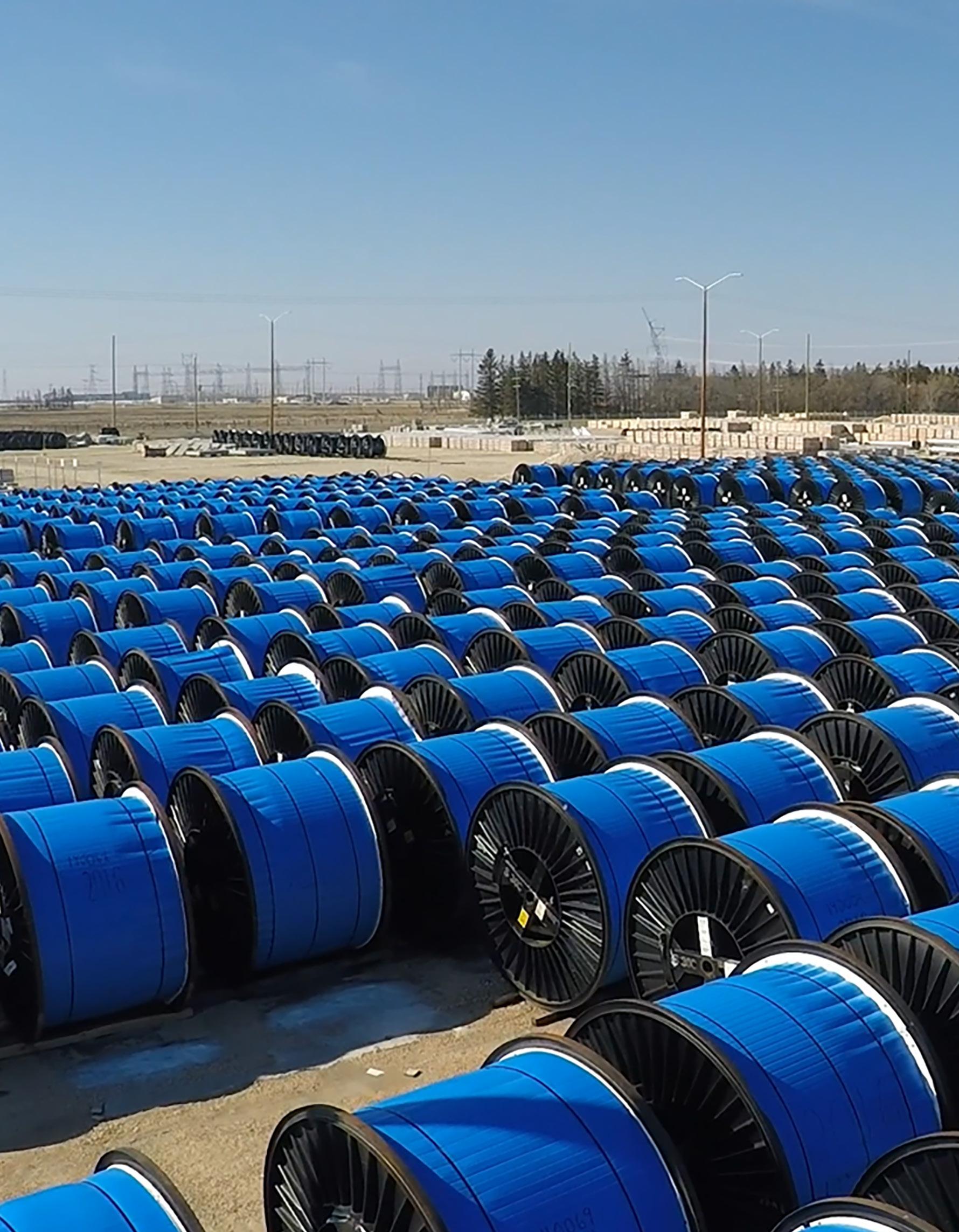
Getting to Yes
2024 State of the Canadian Electricity Industry
Getting To Yes: The State of the Canadian Electricity Industry 2024 is produced by Electricity Canada
1500-275 Slater Street, Ottawa, ON, K1P 5H9 electricity.ca
Prepared by Francis Bradley, Adams Aghimien, Daniella Bidin, Graeme Burk, Diana Dominique, Daniel Gent, Will Greene, Julia Muggeridge, Channa Perera, Michael Powell, Mohit Shah, Jay Wilson, Robin Yee
Special thanks to Travis Sandeski at SaskPower, Vivien Lee at Hydro One, Scott Powell at Manitoba Hydro, Dave Stanley of Ontario Power Generation, Mike Peters and Nick Best at Evolugen
Edited by Graeme Burk and
Julia Muggeridge
Designed by Fatima Khan
Translation by Louise MacKay
© 2024 Electricity Canada
Contents Introduction .................................................................................................................................. 4 Getting to 2050 .......................................................................................................................... 6 A story about utility poles ................................................................................................... 10 Building things faster............................................................................................................. 12 Keeping the grid reliable...................................................................................................... 16 Increasing affordability........................................................................................................ 22 Travelling the road to yes ................................................................................................... 26
Introduction
Francis
Bradley, President and CEO, Electricity Canada
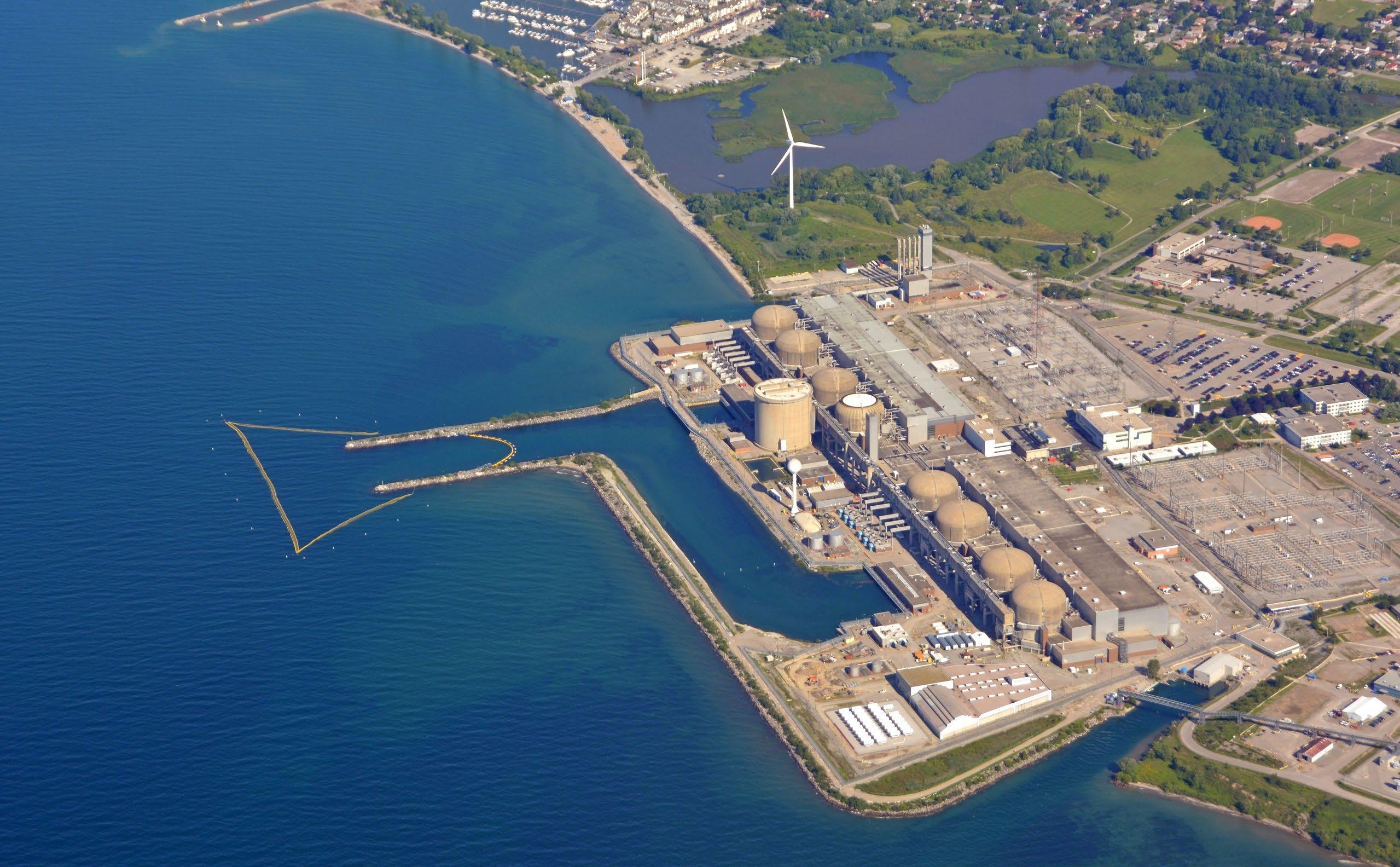
We have a problem building the electricity grid this country needs.
It shouldn’t be this way.
Last year, the federal government pledged $1 in every $8 in new spending would go to clean electricity projects. It’s a commitment to building infrastructure unheard of since the Second World War. The budget reflects many recommendations Electricity Canada has been making to government: the new and expanded tax credits, the funding to the Canada Infrastructure Bank, and the commitments to making processes faster were important developments. All of it signals that investment in electricity and the clean economy reflects the public good.
However…we are not building. Projects are being delayed, or they are held up in approvals. Or worse, they have been halted temporarily, like the recent six-month pause on renewable projects in Alberta, or indefinitely, like the Atlantic Loop in the Maritimes.
This year’s RBC Climate Action Institute report is charting massive growth for electricity, particularly with the rise of electric vehicles and home heating. And yet, their “word of the year” for the electricity sector in 2024 is moratorium

This is a problem across the board, for all construction. In a March 2024 op-ed in the National Post, former Privy Council clerk Kevin Lynch and Paul Deegan, a former public affairs executive at BMO, wrote that “Ineffective regulation … has become an insidious stealth tax on Canadian jobs and growth. Canada is not broken, but our regulatory regime certainly is. Governments have created a regulatory system that discourages capital investment by our own firms, scares away foreign investment and saps our productivity and competitiveness.”
Lynch and Deegan conclude their op-ed by saying, “Rigour and speed are not incompatible... We need to complement rigorous environmental assessments and safeguards with more of a shovel-ready mindset in this country. Our prosperity and growth depend on both.”
The truth is, despite massive gains over the past year, we are dealing with a culture of no
What is the problem?
It’s not a problem of funding. While more needs to be done to make Canada appealing to outside investment, the conditions are good. The Investment Tax Credits introduced by the federal government for clean energy projects will make Canada even more competitive
“We need to come together and figure out all the complicated pieces that connect electricity companies, regulators and Federal, Provincial and Indigenous governments so we can build.”
with incentives in the United States under the Inflation Reduction Act… but while a few of these have been announced, we do need to get on with the legislation for most of them.
It’s also not a problem of technology. We have amazing technology already at our disposal from Small Modular Reactors, to hydrogen generation, to battery storage. And we’re confident that the “not quite there” technology will get there. Just look to the recent announcement from the Province of Ontario and Ontario Power Generation beginning to plan for the deployment of GE Hitachi Nuclear Energy Small Modular Reactors. The industry is forming relationships to get the job done.
It’s not even a problem of principle. Over the past year, we have seen growing provincial opposition to the Government of Canada’s Clean Electricity Regulations. However, no one in leadership in Canada, provincially or federally, is disputing the need for electrification as a long-term solution to our climate crisis.
The only things currently in dispute are the methods and the deadline.
What we have is a people problem.
We don’t have one electricity system in Canada. Each province and territory is different, with different types of ownership – Crown operated, privately run and hybrids of those models.
There is even more disparate local and regional systems of regulation. Consequently, we have one level of government giving direction, another level of government reacting, and multiple regulators offering their own interpretations on what can and can’t be done.
Nothing moves forward as a result.
And as we’ve seen over the past year, the relationship between the federal and provincial governments in this space is geopolitics, pure and simple. All sides have demonstrated the sort of dogmatic posturing one expects out of neighbouring countries, not provinces and a central government in a confederation.
As a result, all we keep getting is no
And the longer we get no, the longer we can’t build, and the longer non-governmental investors will stay out of a space in Canada they’re happy to invest in other countries.
Unless all the parties start talking to each other, and working out some kind of a plan together, we won’t get to yes. Because we need to come together and figure out all the complicated pieces that connect electricity companies, regulators, federal, provincial and Indigenous governments so we can build.
Over the coming pages, you’re going to find a number of suggestions on how we can break the logjams currently holding things up. Because there are lots of ways to move forward—we just need the imagination to visualize them, and the conviction to offer the political capital to make it happen.
We know the technology. We know the goal. We have the potential for investment.
It’s time to get to yes.
The State of the Canadian Electricity Industry 2024 | Getting to Yes 5

Getting to 2050
We have a little more than a quarter of a century before we arrive at Canada’s goal to reach net zero emissions economy-wide in 2050. And much of 2023 was, and it seems, much of 2024 will be spent working out with governments how this is going to be achieved.
And we still have a long way to go.
2023: Electricity’s big year
Electricity had a moment in 2023, with real steps forward towards building a bigger, reliable and more affordable electricity system for 2050. Individual jurisdictions and electricity companies made submissions about how they will expand their system to meet the needs of the future.
Electricity companies are moving forward aggressively on this:
• Hydro Quebec released Action Plan 2035, which commits to investing as much as $185 billion in new generation, transmission, and reliability upgrades between now and 2035.
• BC Hydro revisited its Integrated Resource Plan for 2040, released in 2021, to reflect an increase in near-term demand.
• Memorandums of Understanding were signed between Ontario Power Generation and SaskPower and Capital Power to explore the introduction of Small Modular Reactors.
There were also very significant Federal commitments to support this build out. The 2023 Federal Budget made substantial commitments to the electricity sector, including the creation of the new Clean Electricity Investment Tax Credits (ITCs) , building on similar tools for clean technology, hydrogen, and carbon capture and storage that were announced in previous years. The budget committed additional funds to the Canada Infrastructure Bank and topped up programs like the Smart Renewables Electrification Pathways fund. The budget also committed to finding ways to build faster and simplify the process of getting projects approved. It highlighted the need for tools like Carbon Contracts for Difference (CCfDs) to help de-risk investment.
Getting to 2024
Despite these big announcements, there remain some areas of significant uncertainty. The Clean Electricity Regulations (CERs) – the first draft of which was released in August 2023 – will set limits on how much electricity can be generated from carbon-emitting sources in 2035, and is far from finalized.
There is also a concern about the pace. Since first committing to release details on the proposed CERs in 2021, it took over two years for draft regulations to be shared. The first draft of the regulations were not practicable and would have caused significant reliability challenges in many Canadian jurisdictions. An updated framework in February 2024 was designed to address some of these concerns, but without clear numbers it was impossible to measure the actual impact.
Uncertainty also remains for many measures included in the budget. Implementation legislation for the Clean Electricity ITCs will now only be introduced in the fall of 2024. The availability of CCfDs has narrowed from what was announced in the budget, and few deals have been announced to date. The plan to accelerate approvals is still to come.
The electricity sector has been unambiguous that in order to enable investment and get building, we would need clear, consistent direction from all levels of government—and quickly. The details on how a policy or tool will work are just as, if not more, important than the policy or tools themselves. We will never “get to yes” in terms of decarbonizing the grid without a much faster process for setting policy as well as a process that takes on board concerns from industry, the provinces, Indigenous Peoples and stakeholders to come up with solutions that work in every province and territory, that are feasible and that can work in a reasonable timeframe.
The State of the Canadian Electricity Industry 2024 | Getting to Yes 7

(Bay of Fundy)mental truths
If there is one lesson to take from the first draft of CERs, it’s that there is no one-size-fits-all solution for Canada. We only have one Bay of Fundy, we only have one range of Rocky Mountains, and we only have one prairie stretching across thousands of kilometres. Much of the problem when it comes to the draft CERs is that the modelling used a national average, rather than using detailed local modelling. Canada is a big, diverse country. Exactly nowhere in Canada is average. We shouldn’t be modelling nowhere.
We will be making decisions to allocate trillions of dollars’ worth of investment from the policy derived from these models. That’s a huge bet to be making if the models we base decision-making on aren’t accurate. If the regulations are wrong, compliance will be expensive, and it could make blackouts or brownouts more common, and with bigger impacts. More importantly, it will get us further from the climate goals these regulations are supposed to be helping with. If electricity gets more expensive and less reliable, how likely are people to consider using clean electricity for heating their home, or powering their car?
Getting ready for the future
A decade ago, we didn’t know if there was even a market for zero-emissions vehicles. Heat pumps could be next when it comes to reaching market penetration—RBC’s latest climate report is predicting heat pump use could rise to 10 per cent of Canadian homes by 2030.
Similarly, the last coal-fired unit was built in 2011; it was converted to natural gas in 2021. Alberta is due to be off of coal by the end of 2024. The Federal mandate to get off of coal is for 2030. So why did generators shut the coal plants down early? Because it made technical and economic sense to replace coal with other, cleaner options. The Federal off-coal mandate didn’t force something that wasn’t ready to happen, and it’s important that the CERs follow suit.
All this means we need to be flexible in planning and creating regulations. The dilemma with any long-term planning is that we cannot predict the future, but we need to be ready for it. We need to make plans and be prepared to adjust plans to take advantage of new opportunities.
8 The State of the Canadian Electricity Industry 2024 | Getting to Yes
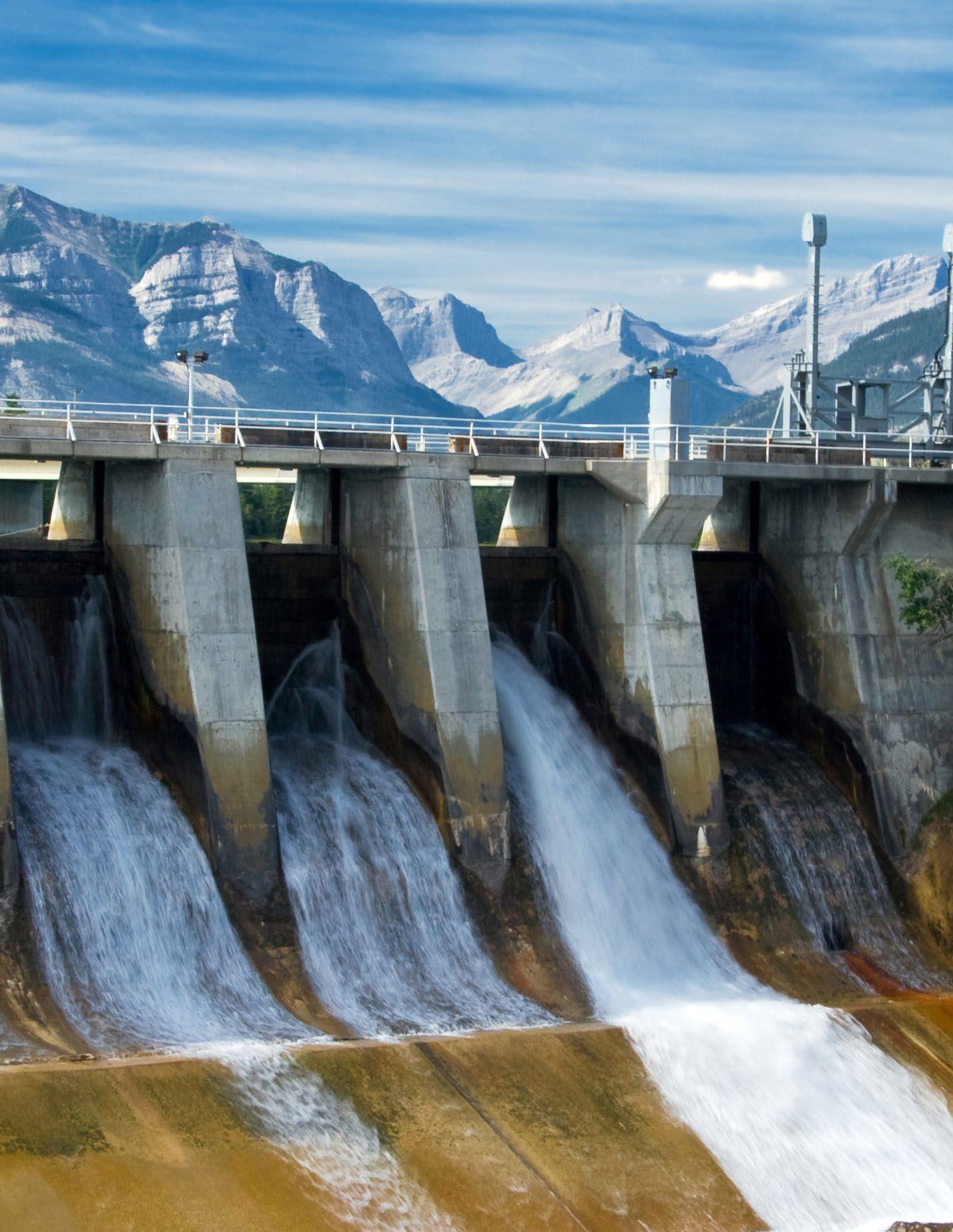
Getting to yes
To build out the grid to improve capacity and continue decarbonization, we are going to need to double or even triple the output of our grid by 2050. This can be done—it would be growth of less than three per cent a year to double it – but it needs to happen every year. Current estimates say it will cost $2 trillion to
meet the 2050 deadline. To get to that goal, we need to focus on these things:
h Make the right investments: This is a great time to build a cleaner, more reliable grid. We are at the start of so many emerging technologies, ranging from battery storage to Small Modular Reactors to hydrogen production. All these things will work in the long term, but in the short term many of these technologies meant to replace fossil fuel-based generation are not yet commercially viable or are dependent on supply chains that are not yet at scale. We need to make investments that will get us further along in the next decade. And we need to work toward realizing these emerging technologies more fully as we get closer to 2050.
h Expand and implement Investment Tax Credits: Investment Tax Credits are the key tools to build net zero infrastructure. Their simplicity and longevity ensure that they are useful tools to electricity companies, who are currently planning large-scale, long-term projects. Provided these tax credits are implemented rapidly and effectively, they will accelerate investment in net-zero projects across the country and help keep bills manageable for Canadians. However, the credits need to invest in all elements of the electricity system: without more investment in transmission and distribution infrastructure, the electrification and decarbonization needed by 2050 will not be possible.
h Smooth the path: Electricity companies will have to make decisions based on the “big picture” at the end of a decades-long build. However, this requires a great deal of support from regulators and government in the here and now. Last summer, the Government of Canada announced the intention to begin work on a Clean Electricity Strategy. This has been one of Electricity Canada’s asks of the federal government for the past several years. We have similar strategies for hydrogen and critical minerals. We need this strategy to really start in 2024 in order to make that big picture much clearer, as everyone involved will better understand the way they need to work together.
It’s time to get some skin in the game
To achieve any of these goals we will require a huge level of collaboration from all levels of government –Federal, Provincial and Indigenous – as well as regulators. It is imperative that everyone builds consensus on the critical need to address decarbonization through electrification, and to address the targets and timelines.
If we want this to succeed, we will need all levels of government on the same page. Right now, such a process seems almost unthinkable. The Provincial and federal governments can sometimes demonstrate almost dogmatic positions on the best way forward regarding electrification. All sides need to show significant leadership and work together.
If the past year has demonstrated anything, it’s that we need more than just funding to make 2050 a reality.
A story about utility poles

It’s a feature on the side of every road in Canada. Most Canadians call it a “hydro pole”, or a “utility pole”. There are other regional variants of this name as well. The humble wooden utility pole is everywhere. It carries electricity across vast distances. It is, and you must pardon the pun, the utility player of the distribution of electricity. They’re grown from pine in new growth forests, and they last up to 30 years. They are the only renewable and sustainably sourced poles in the world.
But we have been dealing with a serious problem realted to utility poles that could cause significant problems for all Canadians. And, right now, there still is no long-term solution.
Utility poles are often first to bear the brunt of extreme weather. In 2022, 3,000 poles were destroyed, mostly from the derecho in central Canada. In Western Canada last year, over 3,000 poles were destroyed due to wildfires.
Fortunately, every electricity provider maintains an emergency supply of thousands of poles.
Unfortunately, with climate change, we’re going through utility poles far faster than we ever have before.
And yet over the past two years we faced the biggest problem with utility poles since they were invented...and it had to do with something that has an unpronounceable name.
Many wooden utility poles are treated with with a chemical called pentachlorophenol (or “penta”). Like many chemical treatments, it is toxic and must be handled properly. Used correctly, the risk to the public, electricity workers, and the environment is managed through safe handling practices. By 2022, the Pest Management Regulatory Agency, an agency of Health Canada, was considering banning it from public use, in line with other countries. Ahead of this, the manufacturer of pentachlorophenol opted to stop selling it altogether.
In the absence of a registered manufacturer, the Pest Management Regulatory Agency accelerated the process of banning penta, setting a date of October
10 The State of the Canadian Electricity Industry 2024 | Getting to Yes
4, 2023. The problem was this ban included existing stocks of penta-treated poles already held by Canadian electricity providers. Under the terms of the proposed phase out, electricity providers would have been unable to use their supply of poles in an extremely short period.
The electricity sector understands the need to transition to alternative wood preservatives to treat utility poles, and for years have been encouraging the approval of alternative wood treatments that were already authorized in other jurisdictions. But this accelerated ban would turn the tens of thousands of existing penta poles sitting in stock yards into garbage. This would have created nothing less than a selfinflicted supply chain crisis, cost millions of dollars, and potentially threatened the reliability of the electricity grid in Canada in the face of extreme weather and expected growth.
In the end, due to the efforts of Electricity Canada and its members, the Pest Management Regulatory Agency approved a registration for the continued use of already-treated poles. This sort of process normally takes years but was expedited in a matter of months. The registration has meant that electricity providers in Canada can continue to use their existing stocks to phase out penta-treated poles until October 2026.
The problem is this story doesn’t really have a happy ending – or indeed any kind of an ending.
Currently, there is no approved, commercially available replacement for penta. And electricity companies still use thousands of utility poles every year. A near-term crisis was avoided, but the overall problem remains. While there are different materials that poles can be made from, it is not easy to just ramp up production of critical equipment overnight. It takes years to scale up manufacturing and the supply chains they rely on. And all this becomes even more complicated as Canada heads into a wildfire season where supplies of utility poles must be ramping up, not down.
The situation with pentachlorophenol-treated poles is illustrative of so many of the problems of “getting to yes”. Electricity providers and government agreed we needed to stop using penta. It’s not a question of what we should do – it’s a question of how we go about it. Approving the registration of existing poles so quickly is to be commended. But we needed to apply this to every part of the process. Because an orderly phase-out of penta could have been planned alongside a scale-up of alternatives. This didn’t happen and it will ultimately adversely affect Canadians who rely on electricity that is carried over utility poles.
In two years, the ban on penta will come in effect—and the reliability of the electricity grid could be in jeopardy.

The State of the Canadian Electricity Industry 2024 | Getting to Yes 11

Building things faster
Suppose you work for an electricity company, and you want to improve the grid so it can provide more clean energy to people. Let’s say you want to build, for the sake of argument, a new transmission corridor that can deliver even more electricity to Canadians and help accelerate the transition to a clean energy economy. This is great news. Now, suppose you’ve managed to get over the various hurdles to secure funding from the federal and provincial governments and private investors. Even better. Can you get building and get on with bringing people more electrons that power their homes and vehicles and all the things that make modern life, well, modern?
Actually, no.
The problem is… even if you get the billions of dollars of funding sorted, you have a myriad of federal regulations to get through. And each statute and associated regulations must be dealt with separately.
And that’s just the federal government. There are still individual Provinces and Territories to deal with. All of them have the constitutional authority to regulate electricity-related activities within their respective jurisdictions.
There are over 80 federal regulations to deal with to get an electricity project approved in Canada, including…
Canadian Energy Regulator Act
Resources and Technical Survey Act
International Boundary Waters Treaty Act
Canada Shipping Act
• Regulation s : 2
Dominion Water Power Act
• Regulations: 1
Canada Petroleum Resource Act
Transportation of Dangerous Goods Act
• Regulations: 1
• Pending: 1
Energy E ciency Act
• Regulations: 1
Canada Wildlife Act
Fisheries Act
• Regulations: 10+
Oceans Act
Species at Risk Act
• Regulations: 1
Greenhouse Gas Pollution Pricing Act
Nuclear Energy Act
Migratory Birds Convention Act
• Regulations: 1
Pest Control Products Act
• Regulations: 1
• Pending: 1
Environmental Enforcement Act
Canadian Environmental Protection Act
• 20+ Regulations, including on coal and natural gas fired electricity, MSAPR, Clean Fuel, PCBs, and the proposed Clean Electricity Regulations
Impact Assessment Act
• Regulations: 4
Railway Safety Act
International Rivers Improvement Act
• Regulations: 1
Navigations Waters Act
• Regulations: 1
Hazardous Materials
Information Review Act
• Regulations: 1
Hazardous Products Act
• Regulations: 1
Environmental Violations
Administrative Monetary Penalties Act
• Regulations: 1
Electricity and Gas Inspection Act
• Regulations: 1
Nuclear Fuel Waste Act
The State of the Canadian Electricity Industry 2024 | Getting to Yes 13
Whose jurisdiction is it anyway?
This brings us to a critical issue with Canada’s electricity regulation regime. While the federal government has made its policy aspirations for the electricity sector quite clear, the regulatory realities are quite different. When it comes to wholesale and retail electricity markets—which determine the cost of service to customers and key infrastructure decisions—these things are regulated at the provincial level by energy regulatory boards and administrative tribunals.
These regulators are not agile and nimble enough (partly due to their rigid legislative mandates) to respond effectively to government policy directions. As a result, we’re stuck between government policy expectations and what the electricity industry can deliver due to the risk-averse decision-making apparatus of Provincial regulators.
Sudden Impact (Assessment)
In October 2023, the Supreme Court of Canada issued an opinion that the Impact Assessment Act (IAA) is, as it stands, unconstitutional. While this was an opinion and not a formal judgment, the federal government has already made a commitment to introduce changes to align with the court’s opinion.
While we’re encouraged by the federal government’s willingness to address the constitutional division of powers, the Federal Impact Assessment system will likely remain complex and ambiguous unless more targeted amendments are considered.
For example, the “Designated Project List” is invoked based on the project type and the size. This happens even when the impacts are already known and quantified, or already assessed through Provincial/ Territorial processes. Furthermore, Federal regulatory resources are already struggling under their current project load. The resulting cumulative timelines are unworkable when the IAA is layered on top of existing Provincial/Territorial Impact Assessments and Federal and Provincial/Territorial regulatory processes.
A browse of the open applications on the IAA website shows that no fewer than six projects –including electricity projects – have been suspended indefinitely because the information-gathering efforts for proponents to proceed with the Federal impact assessment were enough to force a pause.
While some proponents intended at some point to reengage with the process, apparently the paper exercise associated with the IAA was enough of a deterrent to cancel an otherwise viable project, including building natural gas and hydrogen-fueled electricity generating facilities and hydroelectric facilities. All these projects took considerable effort and investment to even get to the assessment stage.
At the current rate of regulatory approvals, new projects may take as much as ten or more years to complete the Federal/Provincial/Territorial Impact Assessment processes and obtain relevant regulatory permits from various government regulators (e.g., Department of Fisheries and Oceans for Fisheries Act Authorizations). When one factors in the federal government’s objectives for the electricity sector to power the decarbonization of the Canadian economy by 2050 – which will require doubling or tripling electricity generation and transmission to meet expected demand – the IAA further strains resources and worsens the existing bottlenecks in Impact Assessment and regulatory processes.
Build things faster
Last year, Electricity Canada commissioned Dunsky Energy + Climate Advisors to identify the barriers to building infrastructure quickly in Canada. To that end, Dunsky interviewed regulators, government, and civil society to talk about what’s holding things up.
What we found were challenges which range from the limited capacity of permitting and regulatory bodies to assess and approve applications, to problems with planning large-scale interprovincial projects. From this data, we offered some solutions that we feel are simple, practical, and achievable. These include:
• Coordinating Federal Impact Assessments and project permitting through a single central Federal office.
• Building capacity for regulators to deliver on net zero goals in their decisions, promptly and effectively.
• Implementing a “one project, one assessment” framework, like the one described in the Federal Budget 2023.
14 The State of the Canadian Electricity Industry 2024 | Getting to Yes

Getting to yes
There are all kinds of things we could do to improve regulation and make things just a little bit easier for everyone to find the approvals they need:
Provincial/Territorial
h Provincial governments need to go beyond traditional electricity-related statutes (like an Electricity Act or an Energy Board Act) and issue more timely policy directives or mandate letters to encourage regulatory innovation and related processes. This would allow regulators to consider innovative electricity sector projects to meet government policy objectives, support research and development efforts, enhance nimbleness and agility in the regulatory processes, and reduce time and costs associated with rate applications.
h Provincial regulators need to consider climate mitigation as much as electricity rate issues and consider the role of the electricity industry in meeting national decarbonization goals, and allow for innovation and “outside-the-box” proposals that would help achieve broader environmental, social, and economic goals.
h Provincial governments also need to establish a non-adversarial regulatory system to enhance trust and collaboration among the key players with the aim of achieving government policy priorities, societal expectations, and best value for customers.
Federal
h At a Federal level, we need to establish a mechanism for greater electricity policy coordination with provinces and secure their support for subsequent directives to energy regulators. This coordinated approach would allow electricity companies to propose initiatives to meet the policy ambitions of governments. There was a promising indication about this last July (2023) when the federal government announced a Clean Electricity Strategy to begin this year. We really need governments to work collaboratively. Without collaboration between the federal government and the Provinces, we won’t be moving anywhere soon.
h There need to be significant changes to the Federal Impact Assessment Act, including;
• Creating a new Impact Assessment “triggering” process based on the potential for significant impacts to areas of Federal jurisdiction (e.g. Fisheries, Species at Risk etc.) rather than projects of a particular type or size as currently designed. This change can be implemented through the 2024 statutory review of the IAA’s Designated Project List.
• Recognizing that certain project reviews can be streamlined or removed altogether, particularly when the impacts are already known and quantified or already assessed through Provincial/Territorial processes.
h We also need to simplify innovation-related funding. Instead of creating “winners” and “losers” through burdensome government funding application processes, we should identify priority issues (like energy efficiency, electrification, hydrogen), find delivery agents (like electricity companies) and allocate Federal dollars based on an appropriate formula (such as a percentage of annual revenues). This would be a win-win proposition for the government and project delivery champions.
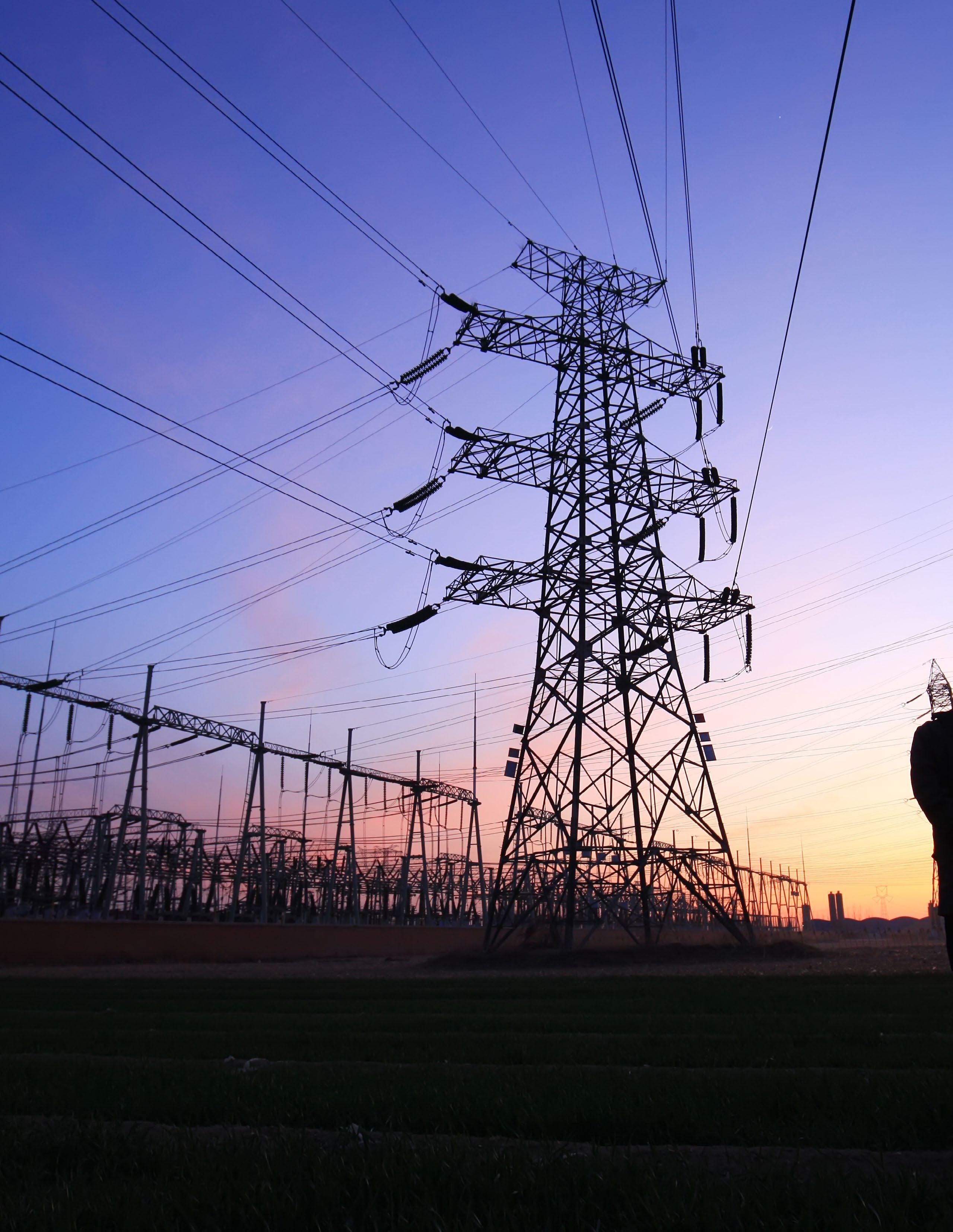
Keeping the grid reliable
The 2020s have offered a word salad of terms for weather the general public has never heard before: Derecho. Polar vortex. Atmospheric rivers. Bombogenesis. Flash droughts. All of these terms sound like they came out of a science-fiction film or TV show, and yet they are happening now, and having massive effects on communities across North America.
Climate change is here to stay. And so is the extreme weather that comes with it.
Hot time, summer in the grid…
2022 featured the largest impact of electricity service to Canadians since 1998, with a national average interruption duration of 14.3 hours. While the data is still being fully collected for 2023, projections are showing last year won’t be as bad—but only just. The next several years will continue to be the same, or worse.
While 40-50 per cent of outages in 2023 were due to weather-related incidents, extreme weather still drove the electricity system to its extreme tolerance. In 2023, one in four people on Earth faced extreme heat and, in Canada, according to Environment and Climate Change Canada, it was the hottest summer since records started being collected in 1948.
“Hot days” in Canada are when the temperature exceeds 30 degrees. Kamloops, British Columbia, recorded 62 hot days in 2023. Temperatures within the Arctic Circle at Fort Good Hope reached a high of 37.9°C on July 8. Through all these hot days—days where the demand for air conditioning put added strain on the system—the grid and its components worked.
Equipment had to be monitored closely to ensure it did not overheat. The grid has now been pushed to its extreme operational limit. And yet it still met demand.
2023: The year of the wildfires
Over 18,000,000 hectares of forest burned in 2023 due to wildfires. Over 186,000 residents were evacuated, and 5,100 personnel were mobilized to fight fires.
During all this, 6,000 wooden utility poles, used for transmission and distribution, were destroyed. Wildfires in Quebec caused power outages in July for over 500,000 customers. Throughout Canada, utilities applied new solutions and lessons learned across the industry to save assets whenever possible.To protect assets, utilities took to fire-wrapping and using fire retardant on over 7,000 poles. Utilities conducted proactive vegetation management within 100 feet of substations. Across the board, utilities increased levels of internal communications with emergency fire response command centres.
System Average Interruption Duration Index, SAIDI (all types of power outages)
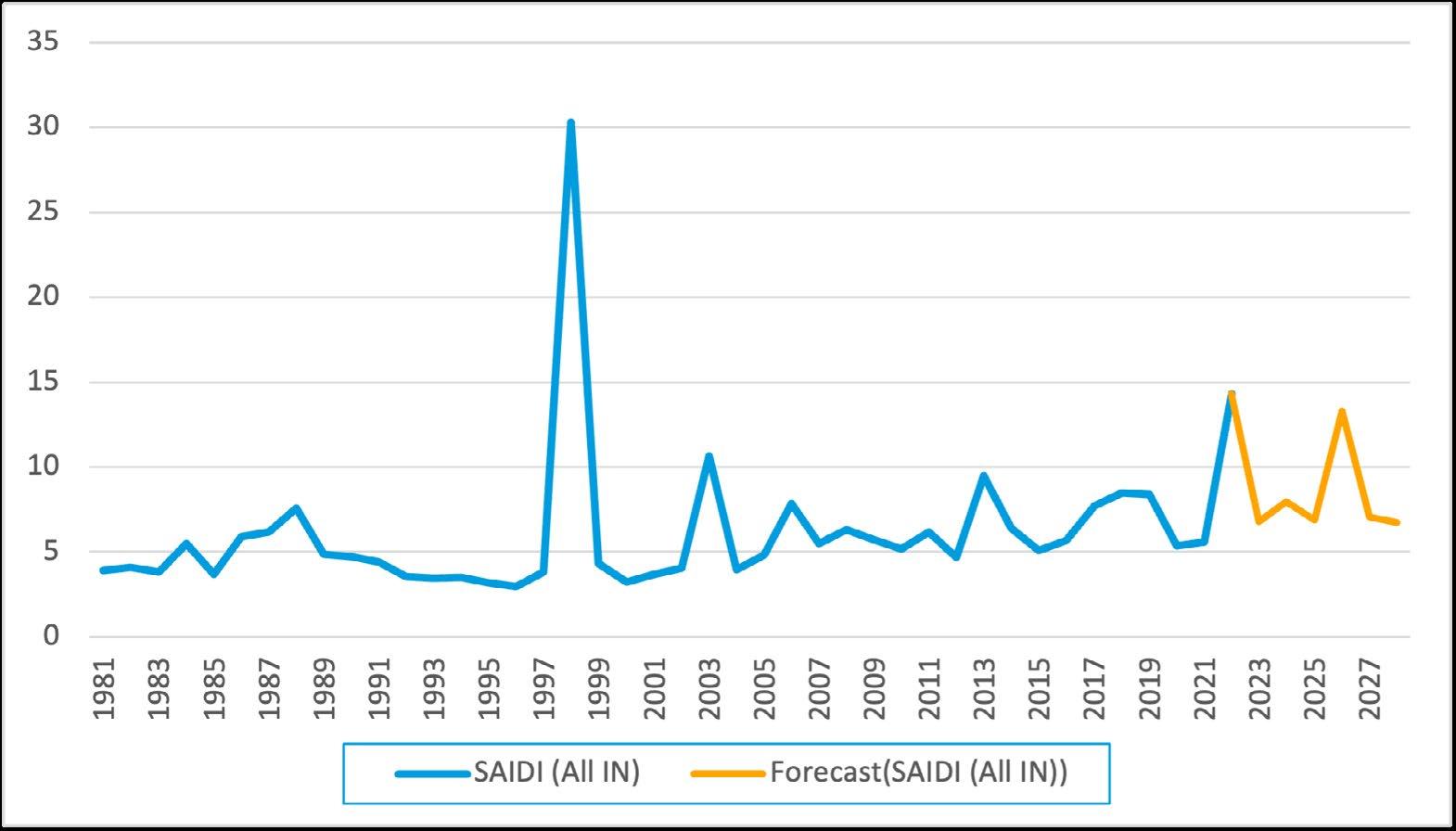
Recorded Forecast
The State of the Canadian Electricity Industry 2024 | Getting to Yes 17
As we brace for impact with another season of wildfires expected, the industry, and regulators need to be proactive and conduct research and development to determine ways to prevent wildfire ignition from electricity assets.
Redefining resiliency in the 21st century
What we really need is an expanded definition of grid resiliency. Grid resiliency suggests building up the grid so it can be protected against wildfires or tornadoes. It doesn’t suggest protecting the grid against an AR-15. And yet, this is what happened to a substation in Moore County, South Carolina in December 2022 when two dozen bullets from a high-powered rifle left 40,000 people without power for four days. We need to build resiliency from attacks by people as much as we do storms.
This includes cyberattacks. For Canadians, cyberattacks do not discriminate based on size or locality. Over the past two years we’ve had attacks on huge, integrated utilities in major populated areas but also attacks on small utilities in Canada’s north. In 2023, the Canadian Cyber Centre issued a report that offers many areas of concern for utilities with large infrastructure. These included:
• Ransomware is almost certainly the most disruptive form of cybercrime facing Canadians due to its impact on an organization’s ability to function.
• The state-sponsored cyber programs of China, Russia, Iran, and North Korea pose the greatest strategic cyberthreats to Canada.
• Cyberthreat actors are attempting to influence Canadians, degrading trust in online spaces. Nation states are increasingly willing and able to use misinformation, disinformation, and malinformation to advance their geopolitical interests.
• Disruptive technologies bring new opportunities and new threats. Digital assets, such as cryptocurrencies and decentralized finances, are both targets and tools for cyberthreat actors to enable malicious cyberthreat activity. Machine learning has become commonplace in consumer services and data analysis, but cyberthreat actors can deceive and exploit this technology. All this is true for quantum computing as well, which will aid threat actors in decrypting stolen information.
Whether the situation is a derecho or a DDOS attack, it’s still a threat to the overall reliability of the grid. We face an infinite number of threats, and we need to learn to be ready for them all at once. And we need to plan for contingencies for when something does break.

18 The State of the Canadian Electricity Industry 2024 | Getting to Yes
Regulation in an age of extremes
In April 2023, the Alberta Court of Appeal offered a judgment in ATCO Electric Ltd. v Alberta Utilities Commission. ATCO took their regulator, the Alberta Utilities Commission (AUC) to court when the AUC denied ATCO the ability to recover some of the costs it incurred because of the 2016 Fort McMurray wildfires. The position of the regulator was that damage caused by the wildfire fell within the definition of “prudently incurred costs and expenses” and should be borne by ATCO shareholders. The court allowed the appeal and referred the matter back to the AUC for reconsideration.
This case highlights an increasing problem for regulators. The rules for regulators were formed in an age when “storms of the century” were literally that, once in a hundred years. Now they’re practically annual events. The rule book needs to change.
Reliability:
The probability that an item will perform a required function without failure under stated conditions for a specified period of time.
Source: Donald Benbow, Hugh Benbow, 2013, Reliability Engineer Handbook, ASQ Quality Press
Resiliency:
The ability to withstand and reduce the magnitude and/or duration of disruptive events, which includes the capability to anticipate, absorb, adapt to, and/or rapidly recover from such an event.
Source: IEEE PES Industry Technical Support Task Force, 2018,The Definition and Quantification of Resilience, IEEE

Getting to yes
h Regulators will need to consider the added costs of wildfire and extreme weather mitigation for those utilities most at risk and incorporate it in their rate filings.
h Timely information sharing can help organizations to prepare and defend against evolving threats, whether that be cyberattacks or extreme weather. There needs to be increased collaboration between industry and government agencies to share threat intelligence and vital information.
h Reliability initiatives such as undergrounding and redundancy builds are critical, and need to be expedited by legislators, through streamlined permitting, and by regulators.
The State of the Canadian Electricity Industry 2024 | Getting to Yes 19

“As we brace for impact with another season of wildfires expected, the industry, and regulators need to be proactive and conduct research and development to determine ways to prevent wildfire ignition from electricity assets.”


Increasing affordability
A Leger poll from August 2023 regarding household finances and economic recession stated that 47 per cent of respondents are living from paycheque to paycheque. For people aged 35-54, that number climbs to 57%.
Over the next two years, 2.2 million families in Canada will be renegotiating their mortgages at substantially higher rates. In fact, interest rates on all credit has gone up, along with groceries, gas and housing costs. None of these things will be coming down anytime soon.
Is it therefore any surprise that affordability is the number one issue for consumers of electricity in Canada?
Climate change is important… except when it impacts your wallet
Every year, Electricity Canada surveys Canadian electricity customers. The 2023 survey provided the electricity sector with much to consider.
• 41% of Canadians who responded said their electricity bill has a major impact on their finances (this percentage is unchanged from the previous year).
• 54% stated that inflation has had a major impact on household finances.
• Over half said that utilities should manage inflation to keep current costs at the same level – even if it means doing less.
• 67% of those surveyed indicated that making electricity prices lower should be a top priority, followed by strengthening the electricity grid to make it resistent to severe weather events and modernizing the grid to use new technology, like solar panels.
It was clear from the survey that while climate change was important to Canadians, it took lower priority if it affected the wallet.
How will the energy transition affect Canadians?
Electricity Canada commissioned Power Advisory to report on how the energy transition might impact Canadians. Power Advisory modelled the costs resulting from changing electricity supply needs and also modelled future demand growth based on a combination of increased electric vehicle and electrified home heating as well as population growth.
The report by Power Advisory suggested that the following increases can be expected by 2035, over and above inflationary increases.
• A 17% bill increase for residential customers
• A 21% bill increase for commercial customers
• A 26% bill increase for industrial customers
Those increases don’t include costs related to electricity delivery. The cost of transmission and distribution could only increase this.
Individual Canadians and families shouldn’t have to shoulder the burden of all these cost increases. This has been said before, but bears repeating: relying on the rate base to fund tomorrow’s grid will inevitably put undue pressure on Canadians today, particularly the most vulnerable.
How not to do affordability
Federal budget 2023 signalled a significant commitment in the electricity space that reflects the public good. But this commitment needs to flow through all levels of government.
For example, provincial governments are often using rate caps to ensure electricity remains affordable. But rate caps are short-sighted and ultimately hinder not only future investment in the clean economy, but also the necessary work needed to make the grid stand up to increasingly extreme weather. Worse, the hard work of building a working relationship with Canada’s electricity regulators that is agile and responsive to current circumstances is made much more difficult when provincial governments can circumvent the regulator with a single stroke.
The State of the Canadian Electricity Industry 2024 | Getting to Yes 23
Moreover, this commitment needs to flow through all levels of the federal government. A case in point is the Excessive Interest and Financing Expenses Limitation (EIFEL) which is currently included in Bill C-59. The EIFEL rules are designed to prevent unreasonable deductions of interest and other financing costs. The focus is principally on multinational enterprises and cross-border investments where the effect of such deductions is tax evasion.
The problem with EIFEL is that the rules are so broadly drafted that they would apply to Canadian utilities. Historically, utilities have been permitted to deduct 100 per cent of their interest expenses which helps them keep costs down for customers. Debt carries interest, and interest rates are high, all of which add significant expense to the debt utilities must carry, and, ultimately, would be borne by customers.

24 The State of the Canadian Electricity Industry 2024 | Getting to Yes

Getting to yes
There are several ways, big and small, to make electricity more affordable. Taking the cost of infrastructure off the bills of Canadians and their families is a start. Initiatives to help low-income people, and to support simple but effective means of energy efficiency are also important.
h Reducing the threat posed by Excessive Interest and Financing Expenses Limitation (EIFEL): EIFEL will limit the amount of interest expense that can be deducted from taxable income for existing and new borrowings. Every dollar of denied interest will be passed on to customers and increase the cost of capital. This will make building electricity infrastructure more difficult, but more than that, it will make electricity bills less affordable. This is why the U.S., the U.K. and other countries have extended exemptions from similar rules, and as a matter of urgency a targeted exemption for regulated utilities must be included in Bill C-59.
h Federal funding for bill assistance: In the United States, the Low-Income Home Energy Assistance Program (LIHEAP) helps keep families safe and healthy through initiatives that assist families with energy costs. LIHEAP provides federally funded assistance to reduce the costs associated with home energy bills, energy crises, weatherization, and minor energy-related home repairs. A similar initiative in Canada would assist the most vulnerable.
h Energy efficiency or conservation programs: Energy equity programs, thermostat installation, insulation rebates and direct install for low-income customers all help people to reduce their energy consumption and their bills. These programs have huge impacts with customers and help curb fluxations in energy prices. Some of the more successful programs developed by Electricity Canada members have included:
• NB Power’s The Enhanced Energy Savings Program provides free mini-split heat pumps and upgraded insulation – along with free installation of both – to homeowners who use electric baseboard heating and have a combined gross household income under $70K. Renters can apply to receive free energy efficiency kits.
• Saint John Energy’s Shave the Peak program which helps customers and the broader public to reduce their energy consumption during anticipated high peaks, particularly in the winter months. The utility also works to curb the demand at peak, through voltage reduction, tapping into energy storage resources and alternative energy generation.
• BC Hydro works with industrial and large commercial customers to help realize energy efficiency savings and electrification opportunities through providing integrated energy audits, feasibility studies, incentives for energy-efficient upgrades and assistance with strategic energy management. BC Hydro stated that over the next few years the company will aim to increase energy savings across the board and are increasing incentive levels to support that goal.
Affordable electricity isn’t just an issue that impacts low-income Canadians. Like the cost of groceries and housing, it is increasingly impacting the middle class. Like everything else facing the sector, there are ways we can make electricity more affordable, reliable and clean. We just need the political will to address them.

Travelling the road to yes
There’s a long journey of building trust on the road to yes. Up until now, we’ve focused on the complicated regulatory and governmental processes electricity companies deal with. But there is another stakeholder that needs to be part of the “Yes” process.
The consumer.
As electricity companies move down the yellow brick road to social license and acceptance, they’ll have to pass through “Willingness to pay more” and “Willingness to build”. While the road is clear with directional signage like, “Early Engagement”, “Community Collaboration” and “Economic Benefits”, human complexity will get in the way.
Social license:
Gaining the support of concerned groups or stakeholders over and above meeting any legal requirements.
The frustrated consumer
But first, a little about the well informed Canadian, overwhelmed by bill payments, worried about a changing climate and looking for a platform to express these concerns.
We’ve seen the next-door neighbour ‘not in my backyard’ attitude or “NIMBY” morph into a culture of NIMBYism – where everyone can express their opinions and beliefs on a variety of channels. Gone are the days of Town Halls. Now, consumers can express their approval or distaste for a pole replacement project instantly using a variety of chat functions and social media tools.
These engaged Canadians are also deeply concerned about rate increases and while they acknowledge a changing climate, they don’t necessarily want to pay the price.
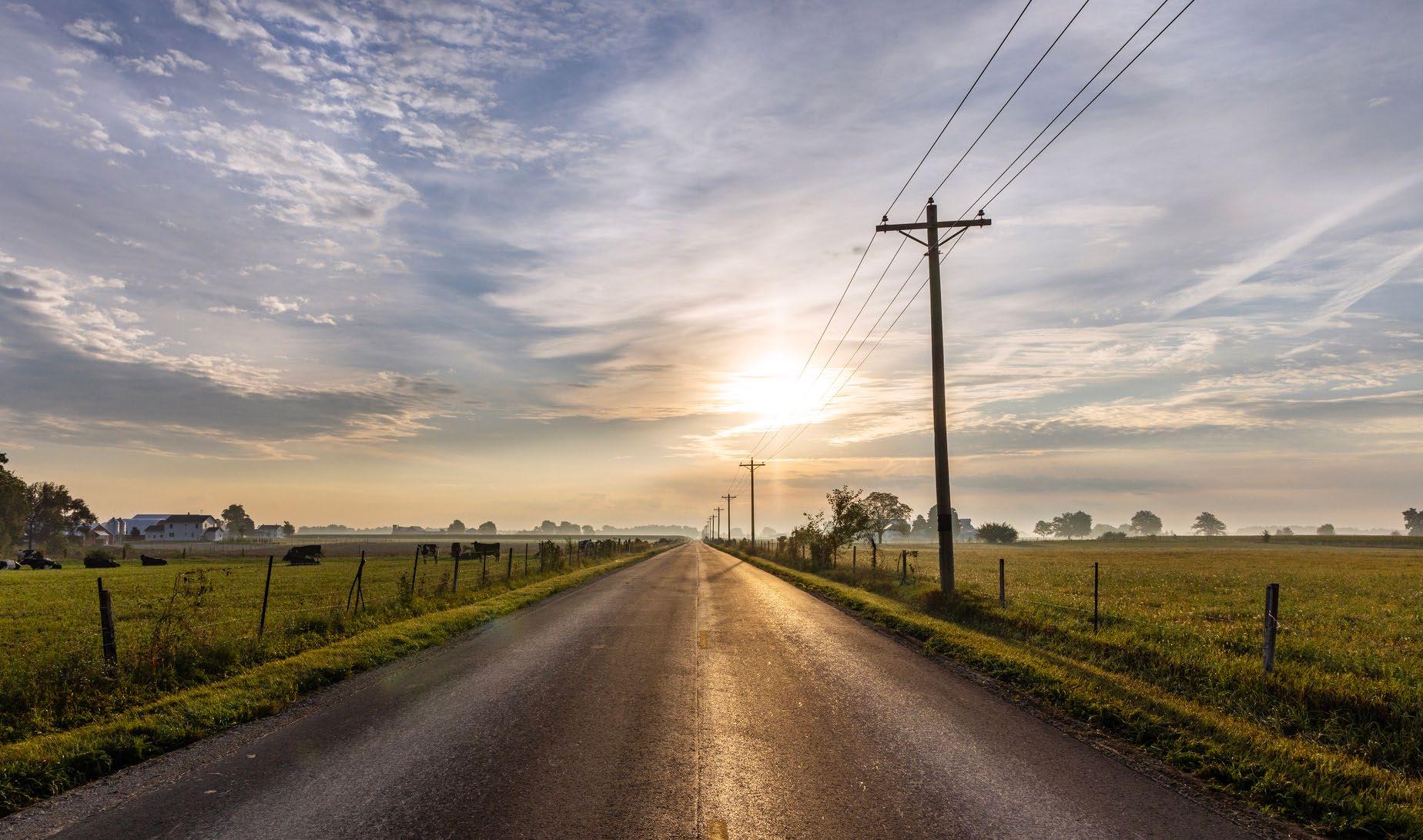
The State of the Canadian Electricity Industry 2024 | Getting to Yes 27
Willingness to pay more
Half (50 per cent) of respondents in a recent Electricity Canada survey would give social permission for a price increase to invest in the electricity system. This number has grown over the years with a 5% increase from 2022. This number is further broken down by those who say increasing the price of electricity is a good idea and they support it (9%), and those who say it’s something they don’t like but think is necessary (41%).
Where does that leave the other half? Those who most believe that climate change is a problem but aren’t willing, or simply can’t afford, to be part of the energy transition. This is complicated by other outside influences like mortgage increases. All this can affect the way consumers view their local distribution company with trust decreasing when mortgages go up.
Willingness to build
At this point on the journey on the road to yes, you’ve just passed through the first service station where you spent months talking to consumers about possible price increases. Some consumers have given you social permission to increase pricing to build new infrastructure. You hope that new programs offered by provincial governments and local utilities will move the other consumers forward.
You will be at the next service station “Willingness to build” even longer.
Years.
Maybe even decades.
This path to earning social license is somewhat formulaic. It’s a process we’ve seen many times before. It’s one of repetitive engagement and consultation. But the formulaic nature begins to make sense when you layer in the complexities of human nature and the physical, emotional, and sometimes historical effects of a new build on a community. That’s when the 72% of Canadians who are open to building gets a little murkier, with only 35% of those people saying new infrastructure is a good idea that they support and 37% saying it’s something they like but don’t think is necessary.
SaskPower’s story
Electricity companies are working through this formula to get to social license, one project at a time. It’s not always easy but their efforts have seen the development of new hydro, new nuclear, new transmission, and new renewables from coast-tocoast-to-coast. And they’ve spent years following those processes on the road to yes. A leading example comes from Saskatchewan.
Since 2021, SaskPower has been actively working to earn social license to build and operate nuclear in the province by the mid-2030s. This work has been a balance between public education but also better understanding regional identities and the current use of identified land.
Some of the first conversations were focussed around “Why nuclear power?” and “What does a nuclear project look like?” This was done during the COVID-19 pandemic, and the stakeholder relations team did most of the early engagement through webinars and online meetings. While not as ideal as in-person engagement, these webinars nonetheless allowed SaskPower to reach a provincial audience through trusted associations and Indigenous partners. These partners enabled SaskPower to reach business and community leaders as well as First Nations and Métis citizens.
Through these webinars, SaskPower received numerous questions related to waste management and water interaction. These early audiences were more curious than concerned and SaskPower was met with some very early support to look at the potential for nuclear power in the province. During early engagements, site selection was also underway and in 2022, two regions, near Elbow and Estevan, Saskatchewan, were announced for further study. Simultaneously, SaskPower triggered the province’s Duty to Consult process and the Indigenous Relations team began consulting with Rights-holders.
With these areas identified, and with COVID-19 restrictions lifted, the process of in-person engagement in 80 municipalities began. SaskPower went to farmers markets, hockey games and would set up shop in regional offices for the day to answer questions residents had about nuclear power. These in-person engagements continue today.
In our conversation with SaskPower, they said, “We aren’t just talking to them about how we plan to use the land. We want to understand how they are using the land.”
28 The State of the Canadian Electricity Industry 2024 | Getting to Yes
A Regional Evaluation Process was also key to developing community champions. The workshops offered a two-way communication opportunity for passionate ambassadors of the region including academics, Indigenous groups, technical observers, and SaskPower representatives. 90% of the people that attended those workshops felt that they were a valuable exchange of information.
Over the next five years, SaskPower will continue to work with Indigenous groups and other stakeholders as SaskPower selects a site and begins the lengthy regulatory process. And yet, even with all these efforts now, SaskPower isn’t planning to make a final investment decision on whether to proceed until 2029.
At the same time, a larger backdrop to this conversation had been underway and was gathering momentum. In 2019 SaskPower had been sharing information and engaging on the need to reduce greenhouse gas emissions. Customers had many competing priorities and preferences for what they hoped to see in the company’s long-term strategy to power the province. In response, SaskPower also launched the Future Supply Plan – 2030 and Beyond engagement project in 2022. It developed a five-stage engagement process to seek public input that will inform the company’s supply plan, while also transparently educating customers about the challenges, opportunities, and trade-offs presented by the energy transition.
Stage 3 of this engagement process, which ended in January, provided examples of net zero supply option scenarios, highlighting things like the cost and land usage for each. , SaskPower received more than 25,000 completed surveys—a significant number in a provincial jurisdiction with 1.2 million people.
It used innovative ways to engage its customers, from take-home discovery kits, videos, popular “Power Talks” webinars, and in-person and online events—all widely advertised to attract participation and build momentum. All this will conclude with the release of SaskPower’s Long-Term Supply Plan this summer.
SaskPower knows the need to continue educating and engaging on Saskatchewan’s power future is nowhere near its end. While it may not be tied to a specific project or regulatory requirement, this is simply how business is done on the road to yes.
Yes
If you’ve taken this route, you’ve earned social license to build…mostly.
Customers will have started to understand why bill increases are needed for the energy transition to happen… mostly.
You are moving closer and closer to social license and acceptance. There will be stumbling blocks but support from government and electricity companies for consumers as they adjust to the energy transition will help:
• Authentic engagement in the meaningful pursuit of clean energy
• Providing consumer choice during the energy transition
• Educating along the way – the more consumers know, the better they will feel
• Welcoming consumers on this journey so they can be part of an electrified future
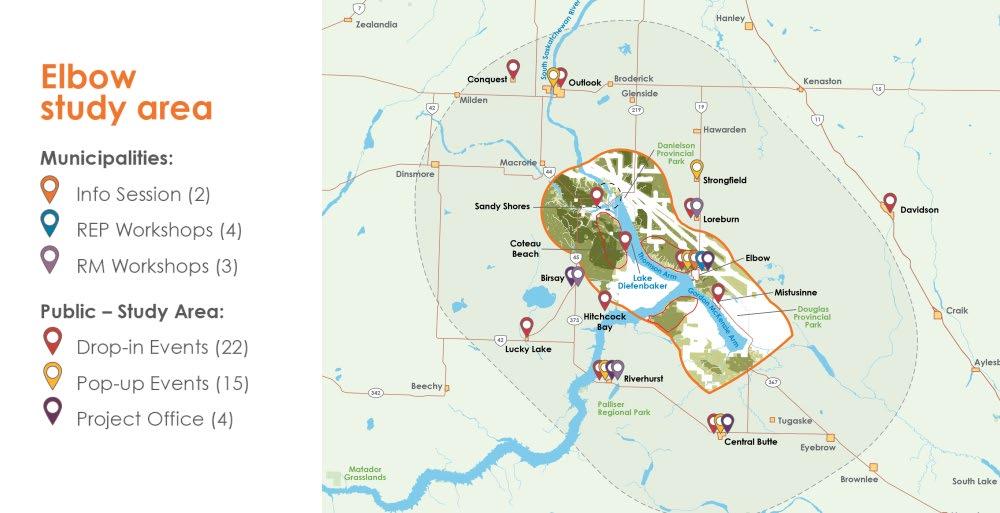
The State of the Canadian Electricity Industry 2024 | Getting to Yes 29

Getting to yes (or “A formulaic process for building social license”)
h Early and transparent engagement: Begin engagement with communities and stakeholders in the early stages of project development. Transparent communication fosters trust and allows for a more inclusive decision-making process.
h Community collaboration: Establish partnerships with local communities and involve them in the decision-making process. Empowering communities to actively participate in shaping the project helps address concerns and ensures their needs are considered. Our Canadian approach is to build relationships with Indigenous communities based on trust, respect, and mutual understanding. We need the wisdom, insights and expertise Indigenous Peoples bring. Not because the courts require it. Not because commercial interests compel it. But because it is the right thing to do.
h Environmental stewardship: Demonstrate a commitment to environmental responsibility by implementing sustainable practices and minimizing ecological impacts. Engage in open dialogue about environmental safeguards, showcasing a dedication to preserving local ecosystems.
h Economic benefits for communities: Clearly articulate and deliver the economic benefits that the project will bring to local communities. This may include job creation, infrastructure development, and other tangible improvements that positively impact residents. In Ontario, Ontario Power Generation has built relationships with more than 50 First Nations and Métis communities, including the Moose Cree First Nation in developing the Lower Mattagami hydroelectric project. This is the largest hydroelectric project in Northern Ontario in 40 years and will generate 450 Megawatts of energy – enough to power about 450,000 homes.
h Inclusive decision-making: As the saying goes, “The old way of doing business is out the window.” Adopting an inclusive decision-making process that considers diverse perspectives is the new norm for companies. Ensuring that all stakeholders have a voice in the decision-making process fosters a sense of ownership and shared responsibility.

“To achieve any of these goals will require a huge level of collaboration from all levels of government as well as regulators. It is imperative that everyone builds consensus on the critical need to address decarbonization through electrification, and to address the targets and timelines. If we want this to succeed, we will need everybody on the same page.”
